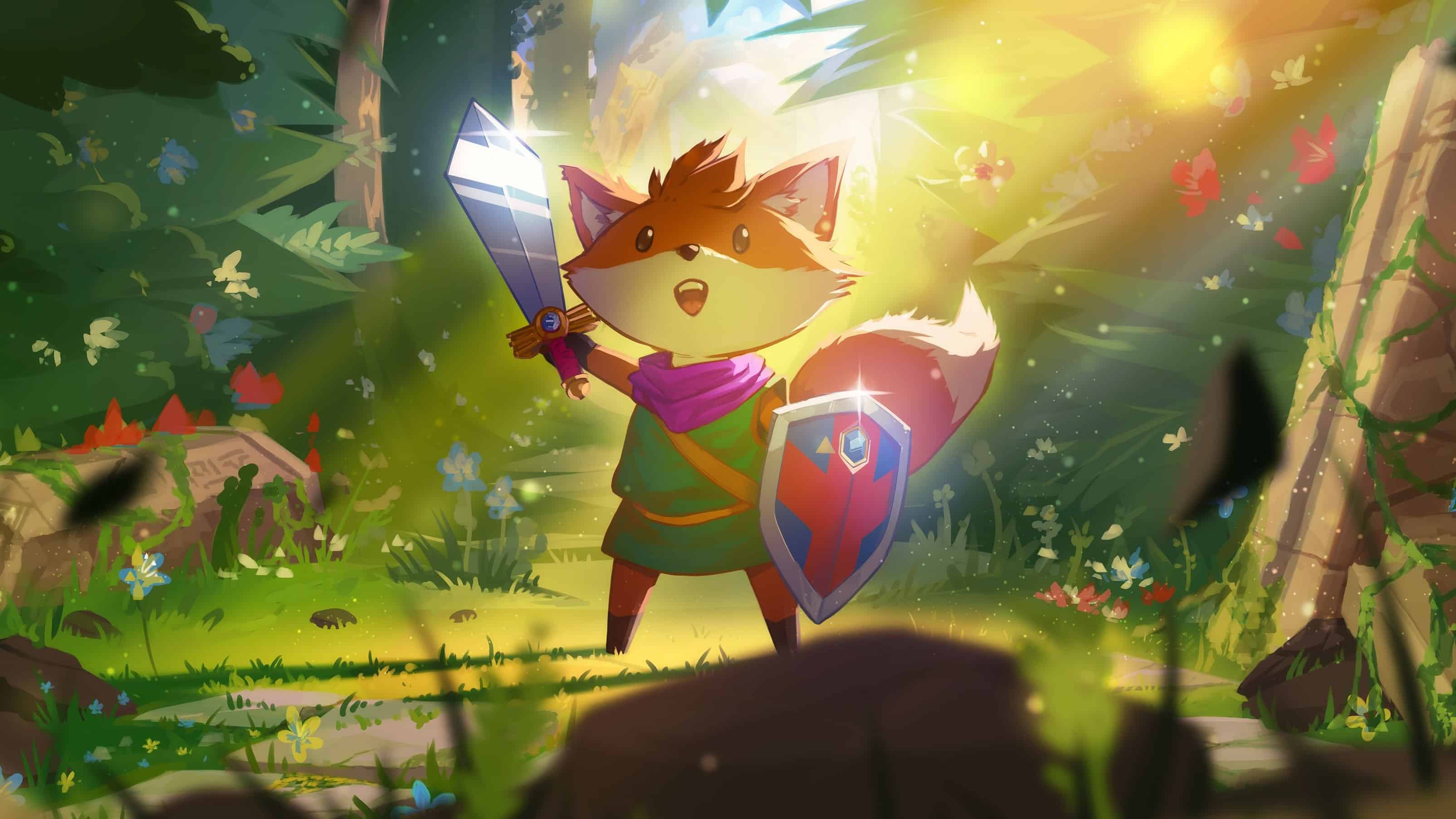Tunic is a great, dare I say, excellent video game. Every aspect of this isometric Zelda-like is well tuned and polished. The visuals are gorgeous. The sound design is impeccable. Everything animates in a pleasingly evocative manner.
But what makes Tunic stand out is not simply the cute little fox and their wonderful misadventures. No, the wonder that sits at the core of this journey is not tied to the swing of a sword or the saving of a world; it is a teasing of your curiosity, a gentle hand leading you down a rabbit hole. It is a game that taps into a long standing and unique tradition of the digital gaming space – the pure joy found in the discovery of the hidden secret.
Uncovering a storied history
For just about as long as video games have existed, there have been secrets hidden inside of them. Warren Robinett’s Adventure, released in 1979 for the Atari, was up until recently credited as the first video game to implement an ‘easter egg’ – a hidden screen featuring the creator’s name in flashing letters, found only by players who follow an arcane set of steps outside the regular mode of play.
Read: Video game easter eggs prove that all games are personal games
Video game culture is rife with secrets, mysteries and tales whispered about on the (physical and metaphorical) playground. Bigfoot, UFOs and a literal easter egg on a pedestal are sprinkled throughout the Grand Theft Auto games. The Diablo series’ rumours surround cows and cow kings. The Batman: Arkham collection has a propensity for esoteric hints about new games, with some not being found until years after release.
Only within the last few years has it come to light that, two full years earlier, another Atari classic – Starship 1 – contains a hidden secret of its own. A secret code can be entered to net the player 10 extra lives, accompanied by the delightfully cheeky message, ‘Hi Ron!’. (Ron Milner, one of the designers of the game, coded the secret in himself. That’s certainly one way to snag the high score at the arcade!)
One particularly juicy secret from the
What drove this secret’s infamy is twofold.
First was the visibility of its parts – or, at least, in-game hints toward them. The ice key is the obvious starting point, but for those dedicated players who collected all 100 Jinjo’s hidden throughout the game, they would be treated to Mumbo – a sometimes helpful shaman character based on a somewhat racist caricature – showing them pictures of the ice key, alongside the locations of two mysterious eggs. Juicy hints that there was more to this game than meets the eye.
Second, it took years and a dedicated community of fans to fully understand and solve. The Rare Witch Project – a community project founded at least 18 months after the game’s release in the year 2000 – was a handful of fans who took it upon themselves to learn everything they could about the secrets hidden in this beloved 3D platformer. The team eventually learned how to break into the code of the game, finding secret phrases that led not only to the ice key, but also to the fact that there were six mystery eggs hidden throughout Banjo’s whimsical worlds.
What did it all mean? What was ‘Stop ’n’ Swop’, the heading of the menu screen that housed these secret items when collected? Questions drove the curiosity of many, cementing the game in the annals of gaming history forever.
Down the rabbit hole
Tunic can be experienced, from start to finish, without engaging in any of its further layers. There’s no requirement to find certain hidden objects to make it to credits. You don’t need to decipher the hidden language to understand what to do, where to go or how to complete your goal. But from the very beginning, Tunic not only tantalises you with the unknown, it puts you in the right headspace to want to know more.
One of the brilliant additions to Tunic is its in-game manual, a collectible discovered by finding pages not-so-subtly hidden throughout the world. These pages act not only as a guide to the player, helping them understand basic mechanics such as dodging and blocking, but also paradoxically hold information back from the player, beckoning them to work at translating it to fully make sense of it all. Each page will show pictures alongside just enough words to intuit meaning, alongside rows of glyphs that at first seem like nothing more than unintelligible markings. And it’s not just the manual – signs in the game world, area and item descriptions, communication with NPCs – everything hints at a whole other layer initially outside the player’s grasp.
The existence of all this plants the idea in the player’s mind from the outset – there is more here to discover. It’s an implicit understanding that you aren’t just being fed the content passively, but need to actively seek it out to understand it. Without consciously doing so, your engagement shifts from top-soil surveyor to tomb-diving archeologist, your senses trained on finding what isn’t immediately obvious. You are primed from the outset to be on the lookout for what might be just beneath the surface.
In a recent interview with Patrick Klepek on Waypoint Radio, lead creator of Tunic, Andrew Shouldice, spoke to a key influence from childhood on his long-awaited project – one of the most classic of video game secrets.
‘I guess my earliest memories of video games was probably Super Mario Bros. The most relevant story I can think of is a very early memory I have of that game: finding the warp zone at the end of 1-2. I mean imagine being a child, and, I don’t know if it was an accident, or maybe putting two and two together, like maybe I was thinking to myself while not playing the game: “hey, wait a sec? There’s this elevator, couldn’t you just… I wonder what is over there?” You walk outside the bounds of the game, and text appears on screen. I don’t remember how old I was at the time, but I’m 99% sure that it was probably the first time I’d ever seen the word ‘warp’ or the word ‘zone’, so I had absolutely no idea what was happening.’
To Andrew, finding these secrets aren’t just about finding something cool. ‘Finding a secret for the first time is not just knowing that you can go down this pipe, it’s suddenly adding a mental question mark next to every pipe you have ever seen or ever will see. It’s enriching the world in a way, making it much more exciting. And the most exciting warp pipes you go down are the ones where you don’t know what’s going on – it feels very profound.’
Secrets in games are genuinely cool, but the best ones are a recontextualisation of everything that came before – and everything that comes after. To play a game is to learn, and then play by, the rules of said game – such as understanding the possibility space within the physics of Mario’s jump, for example. Then, when you use that understanding to seemingly break out of the bounds of what you expect the game to be – that moment can be incredibly special.
Expanding further on the discovery of warp zones in Super Mario Bros, Andrew notes that, ‘Learning a truth about the world – that that bit across the top of the screen is a place you can go – and just the ramifications of that like, “woah, I can go past the [end of the level]” – that’s a very cool feeling. And I mean, people have brought it up before, but Zelda 1 – and it’s the example that people often bring up of a game where, “there’s a secret on every screen!” – once you realise that, you’re like wow, every bush could be a secret, you know? … It suddenly adds this layer of, “what does this mean? This was here the whole time?!” That feeling is really important. That’s one of the things that people will hopefully feel when playing [Tunic].’
We’re in this together
It’s been a long time since a game has captivated me enough to sacrifice the precious few hours of sleep I’m able to hold onto these days. Tunic did that effortlessly, reminding me of those lazy Sundays spent as a kid wandering around Treasure Trove Cove in Banjo, painstakingly bashing out sentences letter by letter inside that dank sandcastle, printed on yellowed dot-matrix paper from my aunt’s dial-up connected PC.
Tunic can be ‘finished’ somewhere in the realm of 12 hours, half that if you already know what you’re doing. But the greatest joy in the game doesn’t come from making it to the end, it’s in the discoveries you make along the way. As a result, Steam tells me my playtime sits at 54 hours – so far.
The main game itself is solid. Moving about the world, defeating enemies, upgrading skills – unfolding your understanding of so many taken-for-granted gamey things, such as how to upgrade your abilities and what some consumable items are used for. I’m still not sure what half of the cards – passive, interchangeable buffs (or maybe debuffs?) – actually do. But working all of that out has been an utter joy – and I couldn’t have done it without the community to help guide me, and to be able to share my discoveries back with them in turn.
You may have read in a few reviews that those who had pre-release access to Tunic were able to access a temporary discord server to connect and discuss the game with. Initially ambivalent, I eventually started working with a few others to dig into the finer layers of what turned out to be an abundance of hidden depth to Tunic – from using the [REDACTED] to find all 20 [REDACTED], discovering the [REDACTED] to find each of the [REDACTED], and finally learning from others in the group about [REDACTED] which was the key to understanding and unlocking the language of the game.
I’m coy on explaining too much, but while there is already a wealth of guides out there, that joy of discovering it for yourself with the help of a few friends swapping notes, is unmatched.
As a kid, I sat and stared at the TV for hours on end, trying different things to try to understand what ‘Stop ’n’ Swop’ was. At the time, I would have given anything to have a few friends just as borderline obsessive interested as I was in uncovering the truth about these mysterious eggs. Stop ‘n’ Swop has since been solved, but Tunic’s deepest mysteries are still yet to be discovered. While there are many, many things about the internet that have caused a negative impact on the human condition, the ability to connect with others anywhere in the world is such a blessing.
Close to release, many of us were stuck on a somewhat esoteric clue for one particular collectible. We’d tried everything we could think of – except decipher the language. It was 8:30 pm on Friday night, and I was tired from a hectic week at the day job. But there was a hint of something nagging in my brain about the language. Five hours later, my bleary eyes no longer able to stay open, I crashed into bed satisfied – with 70% of the language deciphered, and a hint phrase now readable.
The next day, I shared my findings with the group. I couldn’t make heads or tails of it. But as the weekend progressed, I watched as our little group inched closer and closer – then finally, a eureka moment. One of the member’s wives put the final piece in place, and we cracked it. Individually, it’s likely that none of us would have made it that far. Together, we created a shared memory that I know I’ll remember for many years to come.
The joy found
There’s so many things about video games that bring joy to our lives. They can help us feel mastery over a space when our regular lives might feel out of our control. They can connect us with old friends, or help us make new ones. They can use their interactivity to bind us with a digital being, have us resonate emotionally with situations we will never find ourselves in, or give us the tools to handle them if we ever do.
Even the humblest, most unassuming thing – the simplest video game secret – has the power to bring a joy rarely found outside of this medium we enjoy. That ability to re-contextualise everything; to see the world in a light, then open our eyes to a new reality, is invaluable.
Now… Please excuse me. I need to get back to secret hunting.
Explore Our Trusted Gambling Resources
Discover essential guides to casino sites, betting platforms, and crypto casinos—updated for 2026.





